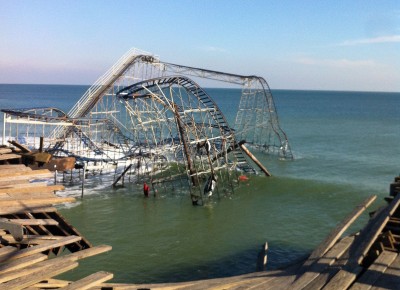
The Jet-Star roller coaster in Seaside Heights, which fell into the ocean during Superstorm Sandy. (Photo: Daniel Nee)
Time magazine’s declaration last week that Ocean County is the nation’s “most dangerous” due to a purportedly high number of natural disasters isn’t sitting well with county officials. For one thing, many news outlets made sure to craft their headlines to leave out the natural disaster angle (we didn’t), leading readers and those seeing the headlines on social media to believe that it was crime, not weather, that earned the county the top spot on the list.
But beyond the predictable pitfalls of living in the social media era, county officials say the numbers used by Time to justify their selection of Ocean County as the most dangerous area in America for natural disaster risk don’t hold water.
“Being deemed the most dangerous place to live in America by an unscientific survey in Time Magazine is nothing short of a disservice to our citizens and this county,” said Ocean County Freeholder Director Joseph Vicari. “This article didn’t compare apples to apples. Time’s own data set does not support their conclusion that Ocean County is the most dangerous place to live due to the ‘frequency of natural disasters'”.
|
|
In an attempt to prove the magazine wrong, David McKeon, Ocean County’s Planning Director, reviewed the data Time used to come to its conclusion about the county’s disaster risk. His first find was that of the 48 natural disasters counted by Time’s staff in their review of National Weather Service records, many simply weren’t natural disasters at all.
For example, the magazine counted events including dense fog and cold weather as natural disasters. Regional differences, McKeon said, mean that the same weather conditions could have occurred many more times elsewhere, but in a more northerly state, the same cold day would not have been counted as a severe weather event.
“The same temperature is common in northern states such as Montana or North Dakota where a 5 degree reading would not be recorded as a weather event,” a statement from the county on their study said.
Ocean County received more “points” toward its designation by similar foul weather events that, while unusual, are not necessarily dangerous (much less disastrous), including heat advisories and winter storm warnings. McKeon’s review also found that the Time study didn’t take in account the severity of weather events – for example, a rare touchdown of a funnel cloud in Ocean County that downs a few trees was given the same weight as an F5 tornado in the midwest that could potentially level a town and claim human lives.
Even using the example of Superstorm Sandy, which heavily weighed on the study’s authors to declare Ocean County as being the most dangerous, county officials say there was no credit given to a well-coordinated evacuation effort that limited casualties to the single digits compared with 1,833 in Hurricane Katrina, which struck the Gulf Coast in 2005 amidst what many considered to be a botched evacuation plan.
Vicari also emphasized that events like tornadoes and earthquakes are much harder to plan for, making them inherently more dangerous to people’s safety than a coastal storm.
“What the study does not take into account is the well tested evacuation procedures in place when such coastal events take place,” he said. “The preparation time for a coastal storm is much greater than for a tornado and earthquake.”
Ocean County officials aren’t the only ones decrying the results of Time’s study. A Sheriff’s lieutenant in the second-most-dangerous county according to the list, Orange County, Calif., conducted a similar study to McKeon’s and likewise concluded the study’s methodology was flawed.
“For example, a recorded rip current with one injury on Sept. 16, 2001 has the same value as the Freeway Complex Fire in 2008, which caused $150 million in damage, according to their database,” Lt. Jeff Hallock told the Orange County Register.
In Orange County’s case, officials were planning to contact the magazine with their findings. In Ocean County, officials were touting infrastructure improvements following Sandy to keep the focus on mitigating risk in the future.
“Since Sandy, Ocean County and many of its sister counties like Monmouth are rebuilding stronger and even safer than before,” Vicari said. “For instance, our roads, like Route 35, are being reconstructed, as are our beaches and many of our businesses and, most importantly, our homes.”












